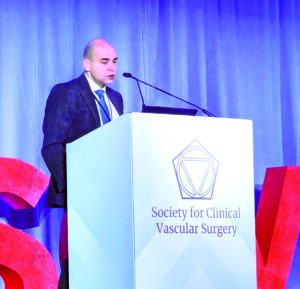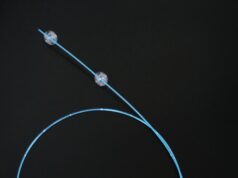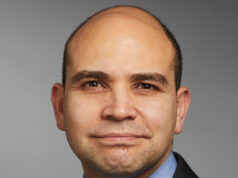
A new subanalysis of the SAVVE (Surgical antireflux venous valve endoprosthesis) trial found that there was no difference in the level of improvement in clinical outcomes and quality-of-life measures between patients who have either primary or thrombotic deep venous reflux.
The data were presented during the Society for Clinical Vascular Surgery (SCVS) 2025 Annual Symposium in Austin, Texas (29 March– 2 April) by Cassius Iyad Ochoa Chaar, associate professor at Yale School of Medicine (New Haven, USA), one of the trial’s site principal investigators and a consultant for the company behind the device.
SAVVE enrolled 75 patients with deep venous reflux in CEAP (Clinical, Etiological, Anatomical and Pathophysiological) categories C4b, C4c, C5 and C6 who were implanted with the novel bioprosthetic venous valve replacement, known as VenoValve (enVVeno Medical), across 21 U.S. sites. The overall one-year SAVVE trial data were first revealed during the 2024 VEITHsymposium in New York City (Nov. 19–23), showing that 85% of the patients achieved a clinically meaningful benefit of a three-or-more-point improvement in revised Venous Clinical Severity Score (rVCSS); a 7.91-point average rVCSS improvement among the rVCSS responder cohort; a clinically meaningful benefit in all CEAP diagnostic classes of patients enrolled; and a 97% target vein patency rate. Additionally, patients also experienced a median reduction in pain of 75% at one year as measured by Visual Analog Scale (VAS).
Among patients with venous ulcers (C6), the median ulcer area was reduced by 87% at 12 months. Patient-reported outcomes demonstrated improvements in quality of life and disease symptoms (VEINES-QOL/Sym).
The latest SAVVE subanalysis compared chronic venous insufficiency patients with primary reflux to those who presented with thrombotic reflux—with the latter defined as those who had a history of venous thromboembolism (VTE), with 80% of the participants bearing a thrombotic etiology.
The only “real difference between the two subgroups of patients was that the thrombotic patients were more likely to be on anticoagulation,” Chaar told SCVS 2025.
More than 50% of trial participants had ulcerations, with the average ulcer area 17cm2. The subanalysis showed that there was no difference between the two groups.
At baseline, the mean reflux time among the entire cohort was three seconds, with an rVCSS score of 16, Chaar continued. “There was no difference between the two groups. Looking at the outcomes of the patients enrolled at one year, there was a significant decrease in the mean rVCSS score in both groups, both the thrombotic and the primary, with an average 6.2- and 8.7-point drop, respectively.
“If you look at the clinically meaningful improvement in rVCSS score, you can see that 85% of the patients achieved that, with an average improvement of 7.5 [thrombotic] and 9.3 [primary] points, respectively,” he said.
“The pain improvement in VAS was significantly increased at one year, with an average of 2.5 points [for both groups], and patient-reported quality-of-life and symptomatic reports also significantly improved at one year in both groups,” Chaar said, adding that, in terms of ulcer area, “the primary reflux group seemed to have a little better reduction in their venous ulceration, with a decrease of 6.6cm2 [thrombotic] and 14.2cm2 [primary], respectively.”
Chaar concluded: “The VenoValve is an effective treatment for patients with deep venous reflux with no other options for treatment. Improvement starts at three months and is persistent at one year, and improvement in clinical patient-reported outcomes and quality of life seems comparable between patients who have thrombotic or primary reflux.”









